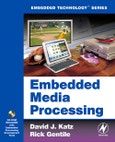A key technology enabling fast-paced embedded media processing developments is the high-performance, low-power, small-footprint convergent processor, a specialized device that combines the real-time control of a traditional microcontroller with the signal processing power of a DSP. This practical guide is your one-stop shop for understanding how to implement this cutting-edge technology.You will learn how to:
- Choose the proper processor for an application.
- Architect your system to avoid problems at the outset.
- Manage your data flows and memory accesses so that they line up properly
- Make smart-trade-offs in portable applications between power considerations and computational performance.
- Divide processing tasks across multiple cores.
- Program frameworks that optimize performance without needlessly increasing programming model complexity.
- Implement benchmarking techniques that will help you adapt a framework to best fit a target application, and much more!
Covering the entire spectrum of EMP-related design issues, from easy-to-understand explanations of basic architecture and direct memory access (DMA), to in-depth discussions of code optimization and power management, this practical book will be an invaluable aid to every engineer working with EMP, from the beginner to the seasoned expert.
Please Note: This is an On Demand product, delivery may take up to 11 working days after payment has been received.








